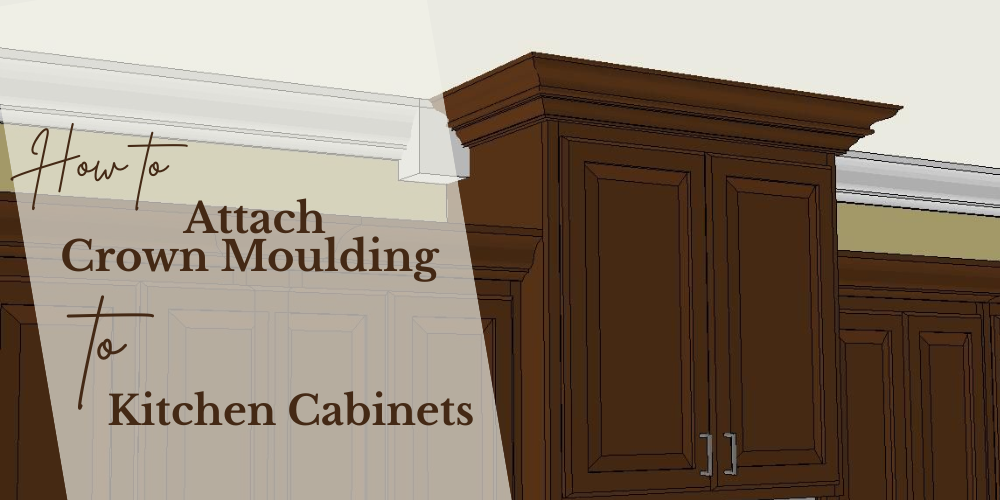
How to Attach Crown Moulding to Kitchen Cabinets
Crown moulding transforms ordinary kitchen cabinets into elegant, custom-looking features that add sophistication and visual height to your space. At TexasVJoint, we believe that with the right guidance and quality materials, anyone can achieve professional-looking results. This comprehensive guide will walk you through everything you need to know about installing crown moulding on your kitchen cabinets.
Whether you're selecting from our premium Crown Moulding collection or planning a complete kitchen makeover with complementary Trim & Cove Moulding and Baseboard, this guide will help you achieve professional results.
Why Add Crown Moulding to Kitchen Cabinets?
Before diving into the installation process, let's explore why crown moulding is such a popular upgrade:
Aesthetic Appeal: Crown moulding creates a finished, high-end look that bridges the gap between your cabinets and ceiling, making your kitchen appear more cohesive and thoughtfully designed.
Increased Perceived Value: This relatively affordable upgrade can significantly boost your kitchen's visual appeal and your home's resale value.
Conceals Imperfections: Crown moulding elegantly hides gaps between cabinets and uneven ceilings, covering up construction flaws or settling issues.
Customization: With various profiles and styles available, you can match your crown moulding to your home's architectural style, from traditional to contemporary.
Materials and Tools You'll Need
Materials:
- Crown moulding (measure your cabinet perimeter and add 10-15% for waste)
- Wood glue
- Finishing nails (1.5" to 2" brad nails)
- Wood filler or caulk
- Primer and paint or stain (to match your cabinets)
- Sandpaper (120 and 220 grit)
Tools:
- Miter saw (compound miter saw recommended)
- Nail gun or hammer
- Measuring tape
- Pencil
- Level
- Coping saw (for inside corners)
- Stud finder
- Safety glasses
- Dust mask
Step-by-Step Installation Process
Step 1: Measure and Plan Your Layout
Begin by carefully measuring the top perimeter of your cabinets. Map out your installation, noting inside corners, outside corners, and straight runs. This planning phase is crucial for minimizing waste and ensuring you have enough material.
Pro Tip from TexasVJoint: Always measure twice and cut once. Account for the spring angle of crown moulding when calculating your measurements.
Step 2: Prepare the Cabinet Surface
Clean the top of your cabinets thoroughly, removing any grease, dust, or debris. If there's a significant gap between your cabinets and ceiling, you may need to install blocking or a backing board first. This provides a solid mounting surface for your crown moulding.
For cabinets that don't reach the ceiling, create a flat mounting surface by attaching a flat board (usually 1x2 or 1x3) to the top front edge of the cabinets. This gives you something substantial to nail into.
Step 3: Cut Your First Piece
Start with the longest, most visible wall in your kitchen. For your first piece, cut one end square (if it meets a wall) or at the appropriate angle (if it meets another piece of moulding).
Understanding Miter Angles: Crown moulding is typically installed at a 45-degree angle against both the wall and ceiling. When cutting, position the moulding upside down on your miter saw, with the ceiling edge against the saw fence.
Step 4: Install the First Piece
Apply wood glue to the back edges of the moulding where it will contact the cabinet. Position the moulding carefully, ensuring it's level and properly seated. Use your nail gun to secure it, placing nails every 12-16 inches. Nail into both the top edge (into ceiling blocking or cabinet structure) and the bottom edge (into the cabinet face).
Step 5: Navigate Inside Corners
Inside corners are where crown moulding installation becomes challenging. The professional approach is to use a coping cut rather than a miter joint, as it creates a tighter, more forgiving fit.
Install the first piece with a square cut into the corner. For the adjoining piece, cut a 45-degree inside miter, then use a coping saw to cut along the profile line, removing the mitered portion. This creates a negative profile that fits perfectly against the first piece.
Step 6: Handle Outside Corners
Outside corners require matching 45-degree miter cuts on both pieces. Measure carefully and make test cuts on scrap pieces first. Apply glue to both mitered surfaces before joining them, and nail both pieces securely once aligned.
TexasVJoint Tip: For outside corners, it's often helpful to slightly undercut the angle (44.5 degrees instead of 45) to ensure the front edges meet perfectly even if the wall isn't exactly 90 degrees.
Step 7: Deal with Long Runs
For runs longer than your moulding pieces, you'll need to create scarf joints. Cut both pieces at matching 45-degree angles (not 90 degrees), with the joint sloping back away from the room's view. This makes the joint less visible and creates a stronger connection.
Step 8: Fill and Finish
Once all moulding is installed, fill nail holes with wood filler. Use caulk to fill any gaps between the moulding and the cabinets or ceiling. Allow everything to dry completely.
Sand the filled areas smooth, starting with 120-grit sandpaper and finishing with 220-grit. Wipe away dust with a damp cloth.
Apply primer if you're painting, then finish with your chosen paint or stain to match your cabinets. Multiple thin coats produce better results than one thick coat.
Common Challenges and Solutions
Uneven Ceilings
If your ceiling isn't level, you have two options: scribe the crown moulding to follow the ceiling line, or use caulk to fill small gaps (up to 1/4 inch). For larger gaps, consider installing the crown moulding level and using a separate trim piece between the moulding and ceiling.
Cabinets That Don't Reach the Ceiling
This is actually the most common scenario. Build out the top of your cabinets with a ledger board or frame, creating a flat surface that extends to meet your desired crown moulding height. This also gives you a dust-catching ledge that's easier to clean.
Matching Existing Trim
Take a sample of your existing trim to a supplier to find the closest match. If an exact match isn't available, consider updating all visible trim in the kitchen for a cohesive look.
Working Alone
Installing crown moulding is definitely easier with a helper, but if you're working solo, create temporary support blocks or use spring clamps to hold pieces in place while you nail them.
Choosing the Right Crown Moulding Style
The profile you choose should complement your kitchen's style:
Traditional Kitchens: Opt for ornate profiles with multiple curves and details. Wider mouldings (4-6 inches) create a more dramatic effect.
Transitional Kitchens: Medium-width mouldings (3-4 inches) with simple, clean curves work beautifully.
Contemporary Kitchens: Consider simpler, more angular profiles or even flat trim stacked in layers for a modern look. Keep proportions modest (2-3 inches). You can also explore our Trim & Cove Moulding for minimalist options that suit modern aesthetics.
Craftsman Style: Choose substantial, squared-off profiles that emphasize horizontal lines.
Maintenance and Care
Once installed, crown moulding requires minimal maintenance. Dust regularly with a soft cloth or vacuum brush attachment. Clean painted surfaces with a damp cloth and mild soap as needed. Touch up any chips or dings promptly to prevent moisture damage.
Why Choose TexasVJoint Materials
At TexasVJoint, we understand that the quality of your materials directly impacts your finished results. Our Crown Moulding collection is crafted for easy installation and long-lasting beauty. We offer a variety of profiles to suit any kitchen style, all made from premium materials that resist warping and splitting.
Whether you're a seasoned DIYer or tackling your first crown moulding project, investing in quality materials saves time, reduces frustration, and ensures professional-looking results that stand the test of time.
To Summarize
Installing crown moulding on kitchen cabinets is a weekend project that delivers impressive results. While it requires precision and patience, the transformation is well worth the effort. Take your time with measurements, invest in quality materials from TexasVJoint, and don't be afraid to practice cuts on scrap pieces before committing to your final pieces.
Remember, even professional installers make mistakes and adjustments along the way. The beauty of working with wood is that small imperfections can usually be filled, sanded, and painted away. The key is careful planning, steady execution, and attention to detail.
Ready to transform your kitchen cabinets? With the right approach and quality materials, you'll be admiring your handiwork for years to come. Happy installing from all of us at TexasVJoint!
